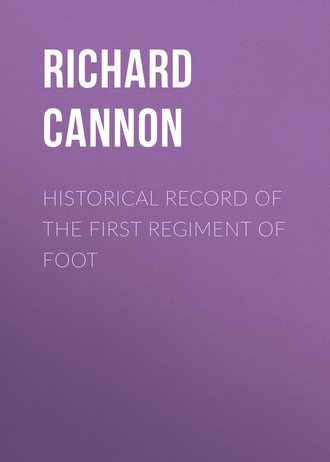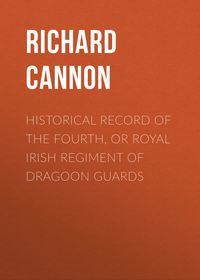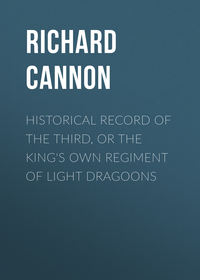 полная версия
полная версияHistorical Record of the First Regiment of Foot
The French, by a night march, gained possession of the heights of Wavrechin, from whence they expected to be able to relieve the town; and the Royals formed part of a division of infantry which advanced to dislodge the enemy; but the position was found too formidable to be attacked, and the regiment retired without firing a shot. During the night a series of works was constructed; a causeway was also made through the deep inundations which the enemy had, by means of sluices on the river, caused to overflow the low grounds near the town; and thus Bouchain was completely invested, and all communication with the troops on the heights of Wavrechin cut off. The siege was then prosecuted with vigour, and the Royals took their turn of duty in the trenches, and in carrying on the attacks, and had several men killed and wounded. The total loss of the British troops in this siege was 1,154 officers and men killed and wounded. The garrison agreed to surrender on the 13th of September. The Royals remained at Bouchain until the works were repaired, and afterwards went into quarters for the winter.
1712In the early part of April, 1712, the regiment once more took the field, and on the 19th of that month pitched its tents near Tournay, where the Duke of Ormond arrived on the 9th of May, and took command of the army, the Duke of Marlborough having, for a political cause, been removed from his military appointments.
On the 19th of May the army advanced, and on the 21st encamped on the hills of St. Denis, near Bouchain; thence proceeding across the Scheldt, arrived a few days afterwards near the frontiers of France; and the two grenadier companies of the Royal Regiment, forming part of a reconnoitring party, advanced a few miles into Picardy.
The siege of Quesnoy was afterwards undertaken, and the Royal Regiment, forming part of the covering army, was encamped at Cateau-Cambresis; but was not engaged in any act of direct hostility. The garrison surrendered on the 4th of July; and soon afterwards the Duke of Ormond having received orders to proclaim a suspension of arms between the British and French, preparatory to a general treaty of peace, the British troops retreated from the frontiers of France to Ghent.
The French monarch having agreed to deliver the city of Dunkirk into the hands of the British as a pledge of his sincerity in the negociations for peace, it was taken possession of by six battalions from England; and on the 4th of August, the Royals, with four other British regiments, twenty pieces of cannon, and four mortars, under the command of Lieut. – General the Earl of Orkney, marched from the camp near Ghent to Dunkirk, where they arrived on the 6th, and the regiment remained in garrison in this city nearly two years.
17131714A treaty of peace having been concluded at Utrecht, the British troops were ordered to return from Flanders. Several regiments embarked in the spring of 1714; the Royals marched from Dunkirk, in May, to Nieuport, where they remained until after the decease of Queen Anne and the accession of King George I., which occurred on the 1st of August, 1714. The first battalion embarked a few days after this event, and landed – seven companies at Dover, and five at Greenwich and Deptford – on the 15th of August; and the second battalion landed at Gravesend and the borough of Southwark on the 22nd of that month. Both battalions assembled in the vicinity of London, and having been reviewed by the Duke of Ormond, afterwards proceeded into garrison at Portsmouth and Plymouth.87 At the same time a reduction of four companies took place, and the establishment of each battalion was fixed at 10 companies, of 3 officers, 2 serjeants, 2 corporals, 1 drummer, and 36 private men each88.
1715After the arrival of King George I. from Hanover, the Protestant succession to the throne appearing to be peacefully established, the Royals were ordered to proceed to Ireland, where the presence of a considerable military force was deemed necessary to restrain the Roman Catholics from taking arms in favour of the Pretender. The regiment was accordingly relieved from garrison duty at Portsmouth and Plymouth by the Third Foot Guards, in March, 1715, and proceeded to Chester, where both battalions embarked for Dublin.
1716171717271728During the remainder of the reign of George I. and the early part of the reign of George II. the regiment was stationed in Ireland. In 1717 its establishment was fixed at 22 companies, of 3 officers, 2 serjeants, 2 corporals, 1 drummer, and 38 private men each; and the expense of the regiment was estimated at £16,710 18s. 4d. per annum. Thus it continued for several years; but in 1727, when 10,000 men were held in readiness to embark for Holland to assist the Dutch in the war with Austria, an augmentation of 20 serjeants, 20 corporals, 20 drummers, and 500 men, was added to the establishment; no embarkation, however, took place, and the regiment was afterwards placed upon a peace establishment.
1737In January, 1737, Field Marshal the Earl of Orkney, who had commanded the Royals nearly 45 years, and had often led the regiment to battle and to victory, died in London; and in June King George II. conferred the Colonelcy on the Honorable James St. Clair, from the 22nd Regiment of Foot.
1740The death of Charles VI., Emperor of Germany, having occurred in the autumn of 1740, the succession of the Archduchess Maria-Theresa, as Queen of Hungary and Bohemia, was disputed by the Elector of Bavaria, and immediate signs of war appearing, an augmentation was made to the strength of the Royal Regiment; and its establishment was increased to 1628 officers and men.
17412nd Batt17421743Previous to this period both battalions had usually been employed at the same station: they were considered as one corps, and few instances occurred of their being engaged in separate services, even for short periods; but on the 21st of October, 1741, while the first battalion remained in Ireland, the second battalion, having been placed on the English establishment, embarked at Cork for the West Indies. It however remained in the West Indies only a few months, and arrived in England in December, 1742, together with the 6th, 15th, and 24th regiments89. In the following year it returned to Ireland.
1st BattIn the meantime, the French having taken part with the Elector of Bavaria against the Archduchess Maria-Theresa, a British force had been sent to Flanders to co-operate with the Austrians; and in the spring of 1743 the first battalion of the Royal Regiment was ordered to proceed from Ireland to Flanders to join the army. It accordingly embarked from Ireland, and on its arrival at Ostend, in June, took charge, together with three other regiments, of the clothing for the army which had marched from Flanders to Germany. From Ostend the Royals marched with the clothing to Brussels, where they arrived on the 10th of July; thence, continuing their route for Germany, passed the Maese on the 14th and joined the army at Hanau, a few days after King George II. had gained a victory over the French at Dettingen. The Royals were afterwards engaged in operations in the west of Germany, but returned to the Netherlands in the autumn.
1744During the following year the first battalion of the Royals formed part of the army commanded by Field Marshal Wade, and was employed in several operations in the Netherlands; but no general engagement occurred.
1745In the spring of 1745 the French besieged Tournay; and the Royals formed part of the army commanded by His Royal Highness the Duke of Cumberland, who advanced to the relief of the town. The French took up a position near the village of Fontenoy to cover the siege; and the Duke of Cumberland, though inferior to the enemy in numbers, resolved to attack the position. The army accordingly advanced to the vicinity of Tournay, drove in the French out-posts on the 10th of May, and on the morning of the following day moved from its camp-ground to attack the enemy. Having passed through some narrow defiles and broken ground, the troops deployed on the plain in front of the enemy, and the British infantry commenced the attack with a spirit and resolution which overcame all opposition. But the Dutch having failed in their attack on the village of Fontenoy, and a brigade of infantry ordered to storm a battery above Vezont having delayed its attack, the British infantry, which had forced the French lines, were exposed to a dreadful cross-fire, and were ordered to retire. A second attack was afterwards made, with similar results: the cavalry advanced to charge; but the failure of the Dutch on Fontenoy, and the delay of the brigade detached against the flank battery at Vezont, rendered a retreat necessary; and the army withdrew from the field of battle, and halted that night under the cannon of Aeth. Although the attack failed, yet the army succeeded in impressing the French with a sense of British valour and magnanimity, and the honour of the British arms was preserved untarnished. The loss on both sides was nearly equal; that of the first battalion of the Royal Regiment was 2 serjeants and 85 rank and file killed; with Captains Thompson and Edmonstone, Lieutenants Cockburn, Nairn, Elliott, Abernethy, and Grant, Ensign Jones, 5 serjeants, and 178 rank and file, wounded; also 8 rank and file missing.
The Royals were subsequently encamped with the army on the plain of Lessines, from whence they retired to Grammont, and afterwards occupied a position near Brussels to cover Dutch Brabant; but the French, by means of their immense superiority of numbers, captured several towns in the Austrian Netherlands. In the autumn the army went into winter quarters.
Meanwhile Charles-Edward, the eldest son of the Pretender, being encouraged by several chiefs of the Highland clans, who were disaffected to the Protestant succession, landed on the western coast of Scotland, and was soon joined by a number of hardy mountaineers, with whom he advanced to Edinburgh, and obtained possession of that city. This success of the young Pretender occasioned the first battalion of the Royal Regiment to be withdrawn from the Netherlands, and it arrived in the Thames on the 25th of October. It was afterwards ordered to form part of the army assembled in the south of England to oppose the threatened descent of the French.
2nd Batt1746In the meantime the second battalion, having embarked from Dublin on the 30th of September, 1745, had arrived in England, and formed part of the army under Field Marshal Wade, assembled in order to prevent the advance of the Highlanders into England. The rebels, however, succeeded in eluding the vigilance of the King's troops, and penetrated as far as Derby. The second battalion of the Royal Regiment was at this time in Yorkshire; and when the young Pretender, being disappointed of the expected aid in England, was forced to make a precipitate retreat to Scotland, this battalion marched in pursuit of the rebels, and arrived at Newcastle-on-Tyne on the 24th of December. From Newcastle this battalion marched to Edinburgh, where it arrived in the early part of January, 1746, and was placed under the command of Lieut. – General Hawley.
The young Pretender had, in the meantime, been joined by some new levies, and having procured a supply of artillery and ammunition, he occupied the town of Stirling and commenced the siege of the Castle. A few regiments having been assembled at Edinburgh, one division, commanded by Major-General Huske, advanced on the 13th of January and drove a party of rebels out of Linlithgow; another division advanced to Barroustouness, and on the 16th the whole proceeded to Falkirk and encamped near the town. On the 17th, about mid-day, the rebel army was discovered advancing towards the high grounds on Falkirk Moor; the King's troops quitted their camp and marched through the broken and rugged grounds towards the enemy, and between three and four in the afternoon the action commenced. But at this moment a tremendous storm of wind and rain beat in the faces of the King's troops and nearly blinded them, and their muskets became so wet that the soldiers could not fire. At the same time the storm beating on the backs of the Highlanders caused them little annoyance, and they charged their nearly blinded antagonists under such advantageous circumstances, that several regiments were instantly broken and driven from the ground. The reserve, however, stood firm, and the Royals having rallied, joined these troops under Major-General Huske. This body of troops made a resolute stand; the storm had abated a little, and when the Highlanders attempted to charge the reserve, they were assailed by a shower of bullets, which caused them to shrink back; and they were eventually driven up the hill with precipitation. This division, of which the Royals formed part, maintained its ground to the last, and remained on the field until dark, when no enemy being in sight, and the night being cold and stormy, the troops retired from the Moor to their camp, and afterwards to Linlithgow, where the soldiers, who were all dripping wet and nearly exhausted, were put under cover, and on the following day they marched to Edinburgh.
Additional forces were afterwards sent to Scotland; the Duke of Cumberland arrived at Edinburgh and took the command; and on the 31st of January the troops were again in motion towards the Highlanders, who raised the siege of Stirling Castle and made a precipitate retreat for Inverness, and one division for the Highlands.
The second battalion of the Royal Regiment also took part in the several movements which preceded the battle of Culloden, which was fought on the 16th of April, on Culloden Moor, a few miles from Inverness. The army had advanced on the 14th to the Royal burgh of Nairn, about 16 miles from Inverness. During the night between the 15th and 16th of April, the Pretender attempted, by a forced march, to surprise the Royal camp, but the out-posts were found alert and the surprise impracticable, and he retreated towards Inverness, and halted on Culloden Moor. On the following day the King's army was discovered advancing in order of battle, with the second battalion of the Royal Regiment on the right of the first line, commanded by Lieut. – General the Earl of Albemarle. The action commenced between twelve and one, and in less than one hour the rebel army was overpowered and chased from the Moor with dreadful slaughter. This victory was decisive. The young Pretender fled from the field, and after wandering for some time in disguise amongst the isles and mountains, he escaped to France. The Royals, after returning from the pursuit of the fugitive Highlanders, pitched their tents near Inverness, where they remained for several weeks, and afterwards marched to Perth.
1st BattThe rebellion being thus finally suppressed, part of the forces in England became disposable for other services; and the nation being at war with France, an attack on the French possessions in Canada was meditated; and the first battalion of the Royal Regiment, being at this period in the south of England, was selected to form part of the expedition, under its Colonel, Lieut. – General the Hon. James St. Clair, which was accompanied by a naval force under Admiral Lestock. The fleet was, however, detained so long by contrary winds that the attack on Canada was deferred, and an attempt on L'Orient, a considerable sea-port on the north-west of France, and the principal station for the French East India Company's shipping and stores, was resolved upon. The expedition sailed from Plymouth on the 14th of September, and on the 20th a landing was effected in Quimperle Bay, and a body of French troops were driven from the shore. On the following day the troops advanced in two columns towards L'Orient, the Royals being in the right column; some French militia fired upon the troops from the woods, but a few skirmishers were thrown out, and the militia were driven back. On arriving at Plemur the leading companies of the column entering the village were fired upon from the houses; but this resistance was speedily overcome, and the villagers were punished for their temerity. On the 22nd the troops appeared before L'Orient, when the governor sent a flag of truce, and proposed to surrender the town on certain conditions. These conditions were, however, considered too favourable to the French, and they were rejected in consequence of a report of the engineers stating the practicability of reducing the town. The siege was immediately commenced, the sallies of the garrison were repulsed, and the town was set on fire in three places by the bombs; but the expedition proved of insufficient force for the capture of the town, and the siege was raised on the evening of the 26th. The roads being bad, four pieces of cannon, one mortar, and some ammunition, were left behind; and the troops retreated to Quimperle Bay and re-embarked without opposition.
In the early part of October another descent was made on the French coast. The troops effected a landing on the peninsula of Quiberon, and Lieut. – General St. Clair, at the head of the Royals and 42nd Highlanders, took a fort with 18 guns, and having fortified the isthmus the troops were cantoned in the villages and farm-houses. The forts and guns in the peninsula, with those in the isles of Houat and Hedic, having been destroyed, and the country laid in ruins, the troops re-embarked and returned to England.
1747The war had, in the meantime, continued to rage in the Netherlands, and the French, having reduced the Austrian provinces, advanced, in April, 1747, into Dutch Flanders, and captured Sluys and Sas van Ghent, and besieged Hulst. The 1st battalion of the Royal Regiment had, in the meantime, proceeded to Holland, and was in cantonments in the province of Zealand, from whence it was detached, with Bragg's (28th) and Lord John Murray's Highland (42nd) Regiments, under the command of Major-General Fuller, to the relief of Hulst, and, having landed at Stapledyke on the 1st of May, was employed in the defence of an outwork called Fort Sandberg. On the 3rd of May the French attacked Sandberg by storm; the Dutch made a gallant resistance, and, on the advance of the British brigade, the enemy was driven back. On the 5th the Royals were on duty in the fort, and the French, having carried the sap along the dyke to within a few paces of the pallisades, attacked the place by storm about nine o'clock in the evening. The assailants advanced with all the spirit and fury which usually distinguishes the first attack of the French; the out-guards and piquets were instantly forced back into the garrison, and a Dutch regiment was disconcerted and gave way. The enemy continued his triumphant career until he encountered the Royals, when a most sanguinary conflict of musketry ensued, which was kept up throughout the night. "The narrowness of the ground in which the battalion was drawn up would not admit of wheeling outwards to the right and left, as is requisite in common street-firing, as it contained only a platoon abreast; so the first platoon fired their 24 rounds, and then filed off man by man, and were succeeded by the next and following platoons, which acted in the same manner; and what is extraordinary, all this, though in the night, was performed without any disorder and confusion."90
The morning light had already dawned upon this scene of conflict and carnage, – between three and four hundred officers and men of the Royals were hors de combat; yet the survivors, – though standing amidst the dying and the dead, and being unable to take one step without treading on a killed or wounded man, – maintained their ground with resolution, and continued to pour their fatal volleys upon the enemy, who had sustained an equal or greater loss, until five o'clock, when the Royals were relieved by the Highlanders; and the French, dismayed by the sanguinary tenacity of the defence, retreated.91 In this desperate service Major Sir Charles Erskine was killed; Lieut. – Colonel Abercrombie, Lieutenants Forbes, Grant, Gordon, and Rutherford, with Ensigns Campbell and St. Clair, were wounded; and several of these officers afterwards died of their wounds: the battalion had also about four hundred non-commissioned officers and private men killed and wounded.92
The fire of the French batteries being resumed with increased fury, Fort Sandberg was rendered untenable a few days afterwards, and the Dutch governor, General La Roque, having resolved to vacate the Fort and surrender the town of Hulst, the British brigade proceeded to Welshorden, where it was attacked by the French; but, having repulsed the enemy, it embarked in small vessels, and, sailing to South Beveland, went into cantonments on that island. The Royals appear to have remained in South Beveland some time, and they did not engage in any other military operation this year.
17482nd BattIn the spring of 1748 the 2nd battalion of the Royal
Regiment, having been withdrawn from Scotland, embarked for Holland, and joined the allied army commanded by His Royal Highness the Duke of Cumberland, at the camp near Ruremonde. Preliminary articles for a treaty of peace having been agreed upon, a suspension of arms took place.
1749Both BattsAfter the conclusion of the treaty of Aix-la-Chapelle, the British troops were withdrawn from Holland, and both battalions of the Royal Regiment proceeded to Ireland, and were placed upon the Irish Establishment in 1749.
1751On the 1st of July, 1751, a warrant was issued under the sign manual for regulating the standards, colours, and clothing of the army, in which numerical titles were given to the several corps, and this was styled the "First, or Royal Regiment of Foot." The rank of the several regiments was first established by a board of general officers assembled in the Netherlands, by command of King William, on the 10th of June, 1694; another board of general officers was assembled by Queen Anne in 1713, to decide on the rank and seniority of regiments raised after 1694; and a third board was assembled by command of King George I. in 1715, on the same subject. These boards decided that English regiments raised in England should take rank from the date of their formation, and Scots and Irish regiments, with English regiments raised for the service of a foreign power, should take rank from the date of their being first placed on the English establishment. Thus the Royal Regiment obtained rank from 1661, as before stated.
In the warrant of 1751 the facing of the Royals is directed to be Blue.93 "In the centre of their colours the King's cypher, within the circle of St. Andrew, and the crown over it; in the three corners of the second colour, the thistle and crown. The distinction of the colours of the second battalion is, a flaming ray of gold descending from the upper corner of each colour towards the centre.94
"On the grenadier caps the same device as in the centre of the colours, white horse, and the King's motto over it, on the little flap.
"The drums and bells of arms to have the same device painted on them, with the number or rank of the regiment under it."
1755Both battalions remained in Ireland until the undetermined limits of the British territory in North America gave rise to another war. The colonies on the coast had extended themselves on every side, while the Indian trade drew many wandering dealers into the inland country, where they found well-watered plains, a delightful climate, and a fruitful soil. These advantages appearing to compensate for the distance from the sea, a company of merchants and planters obtained a charter for a tract of land beyond the Allegany Mountains and near the river Ohio, and commenced establishing a settlement. The French laid claim to this part of the country, drove away the new settlers, and built a strong fort called Du Quesne, to command the entrance into the country on the Ohio and Mississippi. Another dispute had, in the meantime, occurred respecting Nova Scotia.
17572nd BattThese aggressions on the part of the French occasioned a body of British troops to be sent to North America in 1755. War was declared against France in 1756; and in May, 1757, the 2nd battalion of the Royals embarked at Cork, and proceeded with the 17th, 27th, 28th, 43rd, 46th, 55th, and 58th regiments to Halifax, in Nova Scotia, where they arrived in the early part of July, being designed to form part of an expedition under the Earl of Loudoun against an island belonging to the French in the Gulf of St. Lawrence, called Cape Breton. On arriving at Halifax the Royals were landed and formed in brigade with the 28th, 44th, and 55th regiments, commanded by Major-General Hopson; and the expedition was deferred until the succeeding year.





